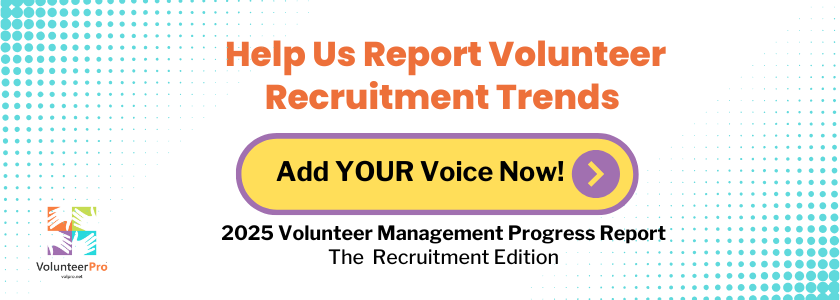
Sara Bumgarner
Volunteer Manager
Visiting Nurse’s Association of the Treasure Coast
How Sara Leveled Up With These Volunteer Management Tools
Valerie: Can you give us a quick overview of your organization and how you work with volunteers?
Sara: Absolutely. I am the Volunteer Manager at the VNA of the Treasure Coast. I have a team of two staff that work with me, and we manage approximately 450 to 500 volunteers annually.
Our agency is a home healthcare agency first and foremost, but we also provide additional services such as private care in home, hospice, wellness programs in the community, and we operate a couple of thrift stores that help us sustain hospice.
So, we have a lot going on at our agency and the volunteers are very instrumental in making sure that daily operations are on track. They do everything from assistance with administrative tasks to hands-on service with our patients. They provide socialization and respite. They provide vigil services to patients who are imminently dying, making sure that they do not die alone.
Volunteers receive a great deal of training supervision and recognition from everyone, not just my team, but everybody at the VNA.
Valerie: That’s amazing that you have that culture baked into the organization. A lot of people don’t have that. It makes it a lot easier to get the support that you need for your volunteer program.
Sara: It does, and it is a work in progress. Anytime you have a new staff person or there’s turnover, you have to start from scratch and help volunteer supervisors understand how to manage volunteers because it is very different from managing a paid staff. So, we don’t always get it right. But we’re constantly trying to implement.
Valerie: Right. I think as a volunteer manager, you don’t realize everything that goes into running a volunteer program. You know, you’re so much more than just a leader, you’re marketing, you’re HR you’re everything rolled into one!
Sara: That is exactly right. We have a very large organization. We have as many paid staff people as we do volunteers. We work hard to make sure that we remember that we are not only providing a quality experience to our patients and consumers, but also our volunteers and our associates.
Sara’s Challenge: Where to Find the Right Support & Tools
Valerie: So, you have been using volunteer management tools and learning techniques that impact your daily volunteer management practices. Can you talk about some of your biggest challenges prior to implementing what you learned from your training and support from VolunteerPro?
Sara: Where do I start? Those of us who’ve been in volunteer work understand that we have similar challenges to anyone else in managing a workforce with, again, going back to those special circumstances of having a workforce that isn’t paid in a monetary way.
So, I would say that some of my biggest pain points were finding tools for compliance and evaluation. I really didn’t have a good foundation for those types of administrative procedures.
I’ve been in volunteer supervision for a very long time, but I really, really benefited from Tobi’s workbooks and guides, but specifically how to evaluate volunteers so that it’s a good experience for both the volunteer and the supervisor. What do they benefit from? How do they benefit from that?
The biggest challenge most recently was how to return volunteers to service during this pandemic.
Tobi’s tools really helped us to identify what our risk factors are and how we’re going to address those. What, some of the challenges are, or some of the fears the volunteers may be facing in returning.
I was able to apply that tool across all of our positions to assess risk and that tool was just unbelievably important to how we get back to in person.
We are very close to that, maybe just about two weeks away.
Sara’s Objective: More Effective Volunteer Management Practices
Valerie: So, I am curious, Sara. How did you first hear about VolunteerPro?
Sara: One of my favorite conference experiences was in Seattle in 2018, the Points of Light Conference, and I attended one of Tobi’s workshops. I just remember thinking at the time that this lady knows what she’s doing, she gets me, she understands my pain points and understands where my joy comes from in my daily work. I gleaned so much from that one-hour workshop.
And I’m glad I did because I have drastically changed the way I manage my daily operations within my team.
Sara’s Result’s: Volunteer Management Tools Helped Sustain
and Grow Her Program
Sara: We have developed a robust program that can sustain itself. We can fully support our department on our own. We don’t need HR. We don’t need marketing. We don’t need really any other support teams because Tobi has shown us how to do it ourselves.
You don’t have to rely on other support teams outside. Of course, you know, it is important, but if we can handle our outreach, our marketing, if we can handle how to train our volunteers and evaluate them appropriately, then we consider that as a huge success. And I do, I consider that to be a very big success for us.
So, because of all the volunteer management tools and guides that we’ve been able to implement, I have been able to secure additional funding specifically through AmeriCorps. And now we’re really growing our program with RSVP and we’ve applied for another grant for another program.
I’m able to grow because now that we have those systems in place, I have more time freed up to dedicate to strategy and planning.
Valerie: That’s amazing. That’s an inspiration to other volunteer managers too.
Sara: For sure. Because I think one of the biggest things that I see from my peers is that they don’t have time. Time is a problem because there is a perception for those who are not in volunteer services that there isn’t that much to do that, you know, you’re just working with volunteers. What could be so time-consuming about that?
But if you want to provide a quality program, it is very time-consuming. It should be time-consuming, but not inefficient. There’s a way to do both, right?
What Sara Wants You to Know
Valerie: What would you say to somebody who is struggling to get support for their volunteer management program?
Sara: I know the biggest question from my agency was, well, how do you justify this expense? Because they think that you should be able to do your job because, once again, you’re just managing volunteers, why do you need training? Why do you need peer support?
It’s because our industry is always evolving. It’s changing. Volunteers are looking for quality experiences where they can utilize their skills.
They want to go deeper. They’re not looking for just maybe an episodic volunteer experience all the time. Now they’re looking to make a real impact. And if you’re not prepared, if you can’t support that, you’re really missing out on an opportunity.
There’s a lot of misconception about what we do, as a matter of fact, sometimes people see my badge and say, “oh, you’re a volunteer”. No, I actually get paid to manage volunteers. So it’s really great that I have VolunteerPro as a resource. And I just thank you guys for all the work that you put into it.


